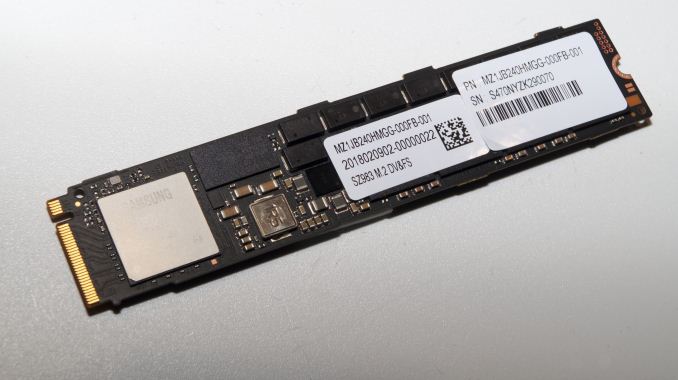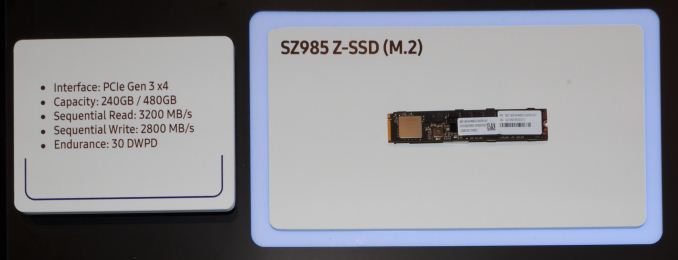Samsung Reveals M.2 Z-SSD
by Billy Tallis on March 27, 2018 8:15 AM EST
Last week at the Open Compute Project (OCP) Summit in San Jose, Samsung's booth included a surprise appearance of a Z-SSD in the M.2 form factor. Samsung has been pitching their Z-SSD SZ985 using Z-NAND memory as a low-latency competitor to Intel's 3D XPoint-based Optane SSDs. The Z-SSD SZ985 has made many trade show appearances over the course of its development, but always in the form of a half-height half-length PCIe add-in card.
That card keeps all the interesting components covered by a heatsink, leaving us with little indication of the PCB's layout, but some of Samsung's earlier presentations included renderings showing a very large SSD controller, similar in size to a typical 16-channel controller. Samsung's exhibit at the OCP Summit included a M.2 version of the SZ985, revealing that the controller is in fact the same Phoenix 8-channel controller used on Samsung's other 98x SSDs, including the PM981 client SSD. This controller is also very likely to be used in Samsung's next generation consumer retail NVMe SSDs, the successors to the 960 PRO and 960 EVO.
Samsung's exhibit called the drive the SZ985 Z-SSD, but the stickers on the drive say SZ983. The capacity of the demo unit appears to be 240GB, the same as the smaller capacity announced earlier this year when the Z-SSD SZ985 officially launched. Samsung's display also listed a 480GB capacity, likely the most first-generation Z-NAND that Samsung can fit onto the M.2 card.
The development of a M.2 Z-SSD raises the possibility of Samsung introducing a Z-SSD for the enthusiast consumer market, to compete against the Intel Optane SSD 800P. However, it is likely that Samsung can remain quite competitive in the high-end consumer SSD space with another conventional MLC-based SSD to replace the 960 PRO. Sacrificing further capacity for incremental performance gains would probably not be worthwhile, even though a Z-SSD doesn't go as far down that road as Optane SSDs.
Source: Samsung













37 Comments
View All Comments
hansmuff - Tuesday, March 27, 2018 - link
So how do I calculate endurance in TBW, assuming a 3 year warranty?I tried the following and it doesn't quite look right:
TBW = 30 [DWPD] * 3*365 [DAYS WARRANTY] * (480 / 1024) [#TB ON DISK] = 15398.44 TBW.
I'm simply taking Drive Writes Per Day assuming it means FULL drive writes, multiply by days of service expected, multiply by capacity in TB. 15,000 TBW just makes no sense to me. A 960 EVO has 400 TBW warranty...
So how do I do this right?
Billy Tallis - Tuesday, March 27, 2018 - link
This is an enterprise drive. Its 30 DWPD rating is on the high side even for enterprise SSDs. (The warranty period is probably 5 years.) Consumer drives are usually rated for 0.1-0.3 DWPD, sometimes up to 0.5 DWPD.This doesn't mean that the enterprise drive will actually survive two orders of magnitude more writes than a consumer SSD. But the warranty will stay valid for 100 times more write volume than the consumer drive's warranty.
Kristian Vättö - Tuesday, March 27, 2018 - link
If you read the small print in consumer SSD warranties, there is often a remark that warranty is limited to PC applications. If it's put inside a server and used in server application, there is actually no warranty at all.Billy Tallis - Tuesday, March 27, 2018 - link
Yeah, but those warranty clauses tend to be on a much shakier legal basis than limits based on objective measurements—the lines between consumer, workstation and server workloads are a lot more debatable than the question of whether a SMART indicator has passed a certain threshold. That's why vendors need to further protect themselves by drastically understating endurance ratings on consumer drives.hansmuff - Tuesday, March 27, 2018 - link
OK, I suppose it makes some sense then. I thought those would be consumer drives.Intel's Optane SSD DC P4800X datacenter drive for example boasts 41.0 PBW, or 41,000 TBW. That brings the Samsung figure back to reason.
msroadkill612 - Wednesday, April 4, 2018 - link
Well I do wish they would ask me :(.They have nvme all wrong.
They are producing the wrong drives for the scarce io lanes.
We are wasting 4 lane 4GB/s links, on mainstream devices which rarely do many 2GB/s reads, and NEVER do 2GB/s writes.
We halve the number of drives we could have if 2 lanes were used, yet benefit little.
The only interim speed between sata & nvme devices it seems, is to use 4 lane nvme devices, but use 4x slower/older pcie gen 2 lanes (yuk).
Afaik, there is no way to bifurcate pcie 3 slots down to 2x pcie gen 3 lanes (outside (yuk latency) chipsets). Pcie 3 x2 is a modern interface that ~matches mainstream drive's capabilities/economics,
Afaik, a 4 normal lane nvme runs fine on 2 lanes. Just less bandwidth available.
This would be a sweet spot even humble makers could realistically compete in. A model category that can read & write reliably at ~2GB/s, and current lane starved intel & amd desktops can consider more drives or a raid pair, for far better speed than the best 4 lane drive.
If there is a way, i would love to hear it?
letumexordo - Wednesday, December 5, 2018 - link
Oooh, with that low latency it would outperform Optane because it has faster speeds but if latency is the same level of Optane or enough to compensate the difference. :DEh, nevermind. It just paired with 800P... lol.